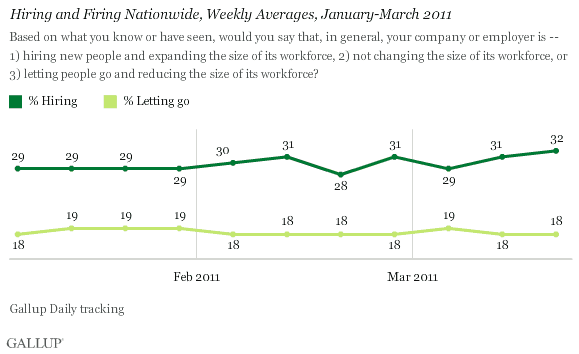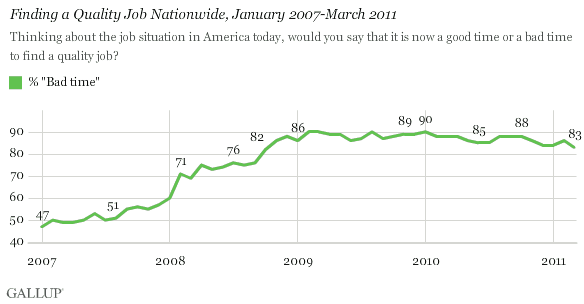PRINCETON, NJ -- Gallup's Job Creation Index reached +14 during the week ending March 20 -- its highest weekly level since the week ending Sept. 28, 2008. Thirty-two percent of employees nationwide say their companies are hiring and 18% say their companies are letting workers go. This is a slight improvement over the prior week, when 31% of companies were hiring and 18% letting go, and a similar reading for the month of February.

Pessimism About Finding a Quality Job Is Lowest Since October 2008
While 83% of Americans in a separate question think March 2011 is a "bad time" to find a quality job, this is the lowest percentage since October 2008. Still, for more than two years, at least 8 in 10 Americans have been pessimistic about the job market.

Implications
The U.S. jobs situation may seem difficult to understand right now. Gallup's Job Creation Index has seen modest improvement during recent weeks -- as have government-reported jobless claims -- but it is still no better now than it was during the deepening recession days of late 2008.
Americans' perceptions of the market for quality jobs have shown similar improvement in recent months. Nevertheless, more than 8 out of 10 Americans believe quality jobs remain hard to find.
In contrast, Gallup's underemployment and unemployment measures have shown no improvement through mid-March. And while there has been slight improvement in recent days, Gallup's unemployment measures remain substantially higher than those reported by the government.
In part, the modest improvement Gallup is detecting may be due to a seasonal improvement in hiring at this time of year; Gallup's jobs data are not seasonally adjusted. There may also be marginal improvement in the jobs picture as a lagged result of improved consumer and business confidence in early 2011.
Regardless, to the degree that the jobs situation is improving, it continues to be insufficient to significantly lower overall underemployment and unemployment. The situation might well improve during the weeks ahead if hiring continues to pick up momentum -- seasonal trends are supportive. On the other hand, it is doubtful that there can be significant job growth as the U.S. economy is buffeted by falling economic confidence and major global and domestic issues.
Survey Methods
Results for Gallup's "quality job" question are based on telephone interviews conducted March 3-6, 2011, with 1,021 national adults, aged 18 and older, living in the continental U.S., selected using random-digit-dial sampling.
For results based on the total sample of national adults, one can say with 95% confidence that the maximum margin of error is ±4 percentage points.
Results for Gallup's Job Creation Index are based on telephone interviews conducted during the months of January, February, and March 2011 as part of Gallup Daily tracking, with a random weekly sample of more than 3,000 respondents, aged 18 and older, living in all 50 U.S. states and the District of Columbia, selected using random-digit-dial sampling.
For results based on the total weekly sample of national adults, one can say with 95% confidence that the maximum margin of sampling error is ±2 percentage points.
Interviews are conducted with respondents on landline telephones and cellular phones, with interviews conducted in Spanish for respondents who are primarily Spanish-speaking. Each daily sample includes a minimum quota of 200 cell phone respondents and 800 landline respondents, with additional minimum quotas among landline respondents for gender within region. Landline respondents are chosen at random within each household on the basis of which member had the most recent birthday.
Samples are weighted by gender, age, race, Hispanic ethnicity, education, region, adults in the household, cell phone-only status, cell phone-mostly status, and phone lines. Demographic weighting targets are based on the March 2010 Current Population Survey figures for the aged 18 and older non-institutionalized population living in U.S. telephone households. All reported margins of sampling error include the computed design effects for weighting and sample design.
In addition to sampling error, question wording and practical difficulties in conducting surveys can introduce error or bias into the findings of public opinion polls.
For more details on Gallup's polling methodology, visit www.gallup.com.
